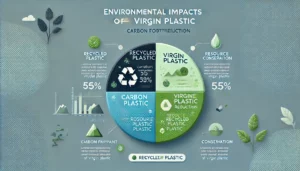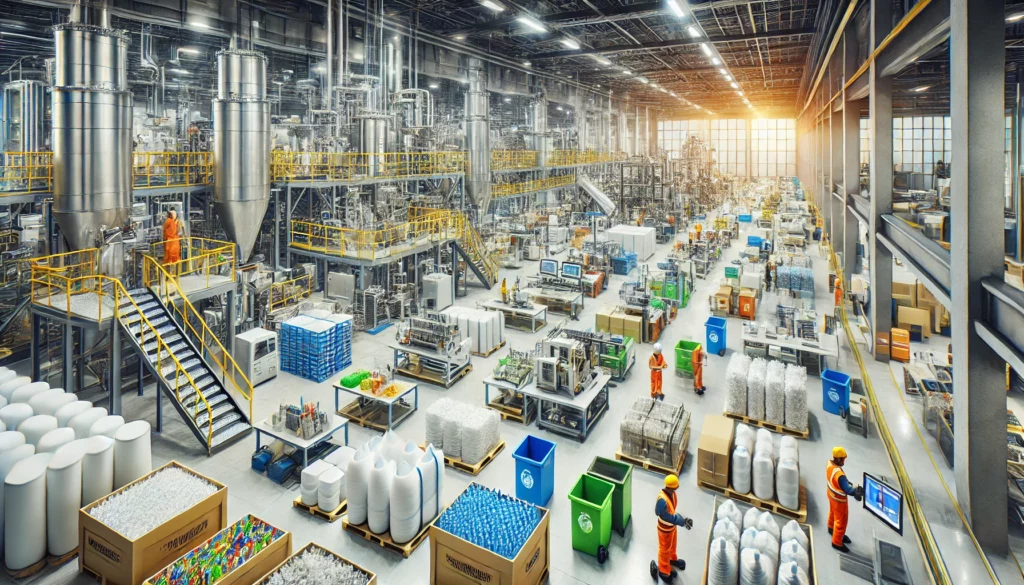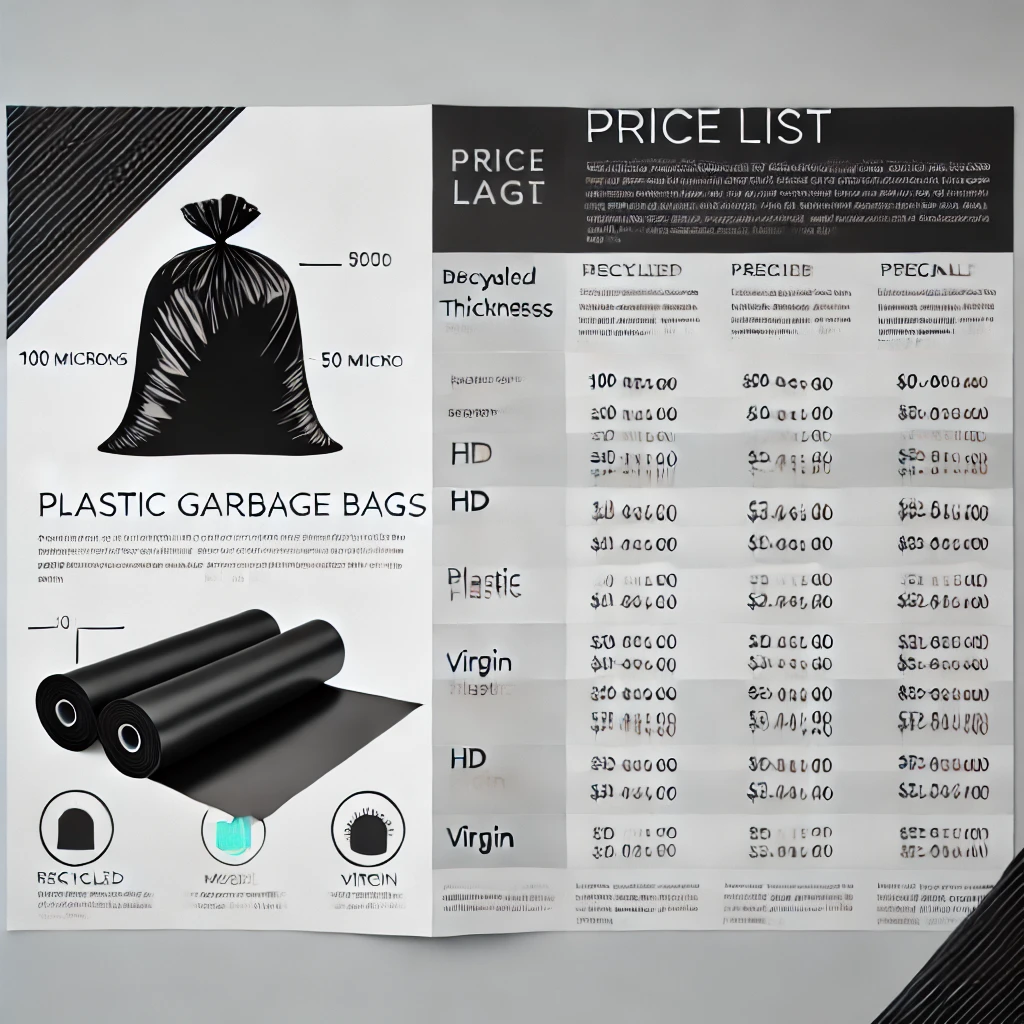Introduction
In today’s environmentally conscious world, the decision between using recycled or virgin plastic is not merely a matter of cost—it encompasses considerations of sustainability, product quality, and long-term environmental impact. This detailed examination provides a 360-degree view on the implications of each choice, helping businesses and consumers make informed decisions that align with their economic goals and environmental values.
Section 1: Economic Implications
1.1 Cost Analysis and Material Efficiency
The economic argument for using recycled plastics often hinges on the lower cost of raw materials. Recycled plastics typically cost about 3 AED per kilogram in markets like the UAE, which is significantly less than virgin plastics. However, this cost advantage may be misleading once production efficiency and material requirements are factored in.
Case Study: Plastic Bag Production
Consider the production of plastic bags with specific dimensions (95×120 cm and 110×130 cm). The difference in material thickness required for recycled and virgin plastics (100 microns vs. 45 microns, respectively) leads to a drastic difference in production output and cost:
| Size (cm) | Plastic Type | Thickness (microns) | Weight per Bag (g) | Bags per Kg | Cost per Bag (AED) |
|---|---|---|---|---|---|
| 95 x 120 | Recycled | 100 | 104.88 | 9.53 | 0.315 |
| 95 x 120 | Virgin | 45 | 47.20 | 21.19 | 0.269 |
| 110 x 130 | Recycled | 100 | 131.56 | 7.60 | 0.395 |
| 110 x 130 | Virgin | 45 | 59.20 | 16.89 | 0.337 |
Profitability Analysis
By comparing the total costs and potential revenues from filling a 25-ton container with each type of plastic, we observe significant differences in profitability due to the higher efficiency of virgin plastic.
1.2 Global Market Implications
Converting these findings into USD provides a global perspective that is critical for businesses involved in international trade. The price differences and efficiency metrics become crucial for understanding competitive pricing strategies in global markets.
Section 2: Quality Considerations
2.1 Material Properties: Strength, Odor, and Aesthetics
Virgin plastics are generally superior in terms of strength, odor neutrality, and aesthetic properties. These factors are critical in industries such as food packaging, medical supplies, and consumer goods where safety and consumer perception are paramount.
2.2 Consumer Perceptions and Market Trends
The market is increasingly demanding high-quality, aesthetically pleasing products that also adhere to environmental standards. The challenge of meeting these demands with recycled plastics can influence a company’s brand reputation and market share.
Section 3: Environmental and Regulatory Factors
3.1 Environmental Impact Assessment
Recycled plastics contribute significantly to reducing landfill waste, lowering greenhouse gas emissions, and decreasing the dependency on fossil fuel-derived raw materials. However, the recycling process itself and the quality of the recycled output must be considered to fully understand the environmental benefits.
3.2 Regulatory Landscape
Global and regional regulations regarding the use of recycled materials are tightening, with many countries implementing stringent standards on recycling processes and the quality of recycled products. These regulations can affect the viability and cost-effectiveness of using recycled plastics.
Section 4: Long-term Strategic Considerations
4.1 Technological Advancements in Recycling
The future of recycled plastics is heavily dependent on technological advancements that improve the quality and reduce the cost of recycled materials. Innovations in sorting and processing technologies could potentially close the current performance gap between recycled and virgin plastics.
4.2 Strategic Implications for Businesses
Companies must weigh the short-term costs against the long-term benefits of aligning with sustainability goals. Adopting recycled plastics can enhance a company’s environmental credentials and appeal to a growing segment of eco-conscious consumers, but must be balanced with cost, performance, and regulatory compliance considerations.
Section 5: Profit Margin Comparison Between Virgin and Recycled Plastic
When making decisions about material choices in manufacturing, understanding the cost implications in terms of transportation, storage, and purchase expenses is critical. This section provides a detailed calculation of the potential profit margins that can be achieved by opting for virgin plastic over recycled plastic, taking into account the number of units that can be transported and stored, as well as the cost per unit.
5.1 Cost Efficiency in Transportation and Storage
The transportation and storage costs can significantly impact the overall cost-effectiveness of the plastic material used. Virgin plastic, with its higher density and lower required thickness, allows for a greater number of products per unit volume, significantly reducing logistics costs.
Example Calculation for Container Load:
Assuming a standard container can hold 25 tons of material, we calculate the total number of plastic bags (size 110×130 cm) that can be transported:
- Recycled Plastic: 100 microns thick, 131.56 grams per bag
- Virgin Plastic: 45 microns thick, 59.20 grams per bag
The number of bags per 25-ton container:
| Plastic Type | Weight per Bag (g) | Bags per Kg | Total Bags in 25 Tons |
|---|---|---|---|
| Recycled | 131.56 | 7.60 | 190,000 |
| Virgin | 59.20 | 16.89 | 422,250 |
5.2 Profit Margin Calculation
To calculate the profit margins, we consider the selling price per bag is constant across both materials, but due to the different costs and quantities per container, the margin differs.
Assuming a selling price of 0.50 AED per bag, the profit per container can be calculated as follows:
| Plastic Type | Cost per Bag (AED) | Selling Price (AED) | Profit per Bag (AED) | Total Profit per Container (AED) |
|---|---|---|---|---|
| Recycled | 0.395 | 0.50 | 0.105 | 19,950 |
| Virgin | 0.337 | 0.50 | 0.163 | 68,782.75 |
5.3 Analysis of Results
The above table illustrates that choosing virgin plastic not only allows for more units to be transported and stored per container, but also significantly increases the profit margin per unit sold. The higher number of units transported in virgin plastic further amplifies the total profit margin achievable per shipment.
- Profit Increase: Using virgin plastic can potentially increase profits by 245% per container compared to using recycled plastic, solely from the cost and volume perspective.
Conclusion on Profit Margins
This comparison clearly shows that while recycled plastic might seem cheaper per kilogram, the total economic benefit, when considering transportation, storage, and profit per unit, leans heavily in favor of virgin plastic. Businesses must consider these broader economic factors when making strategic decisions about material choices, as the initial lower cost of recycled materials may not translate into higher profitability in operational contexts.
6. Detailed Profit Margin Analysis with Calculated Percentages
This section focuses on quantitatively comparing the profitability of using virgin plastic over recycled plastic, including a formula-based calculation of profit margins and the percentage increase in profit. This analysis will consider not only the cost per unit but also the increased efficiency in transportation and storage.
Formula for Calculating Profit Margins:
The profit margin for each type of plastic can be calculated using the following formula:
Profit Margin %=(Selling Price per Bag−Cost per BagSelling Price per Bag)×100\text{Profit Margin \%} = \left( \frac{\text{Selling Price per Bag} – \text{Cost per Bag}}{\text{Selling Price per Bag}} \right) \times 100
Example Calculation for Container Load:
Let’s revisit the previous example with detailed calculations for a standard container holding 25 tons of material, now adding the percentage profit margin:
| Plastic Type | Weight per Bag (g) | Bags per Kg | Total Bags in 25 Tons | Cost per Bag (AED) | Selling Price (AED) | Profit per Bag (AED) | Total Profit per Container (AED) | Profit Margin % |
|---|---|---|---|---|---|---|---|---|
| Recycled | 131.56 | 7.60 | 190,000 | 0.395 | 0.50 | 0.105 | 19,950 | 21% |
| Virgin | 59.20 | 16.89 | 422,250 | 0.337 | 0.50 | 0.163 | 68,782.75 | 32.6% |
Analysis of Profit Margin Table:
The table demonstrates that not only does virgin plastic allow for a higher number of bags per container, but it also offers a significantly higher profit margin per bag sold. Here’s the analysis:
- Recycled Plastic: The profit margin is 21%, totaling AED 19,950 in profits per container.
- Virgin Plastic: The profit margin is 32.6%, with a total profit of AED 68,782.75 per container.
This represents a profit margin increase of 55.2% when using virgin plastic over recycled plastic. This increase is calculated using the difference in profit margins between the two materials.
Conclusion on Profit Margins
The detailed calculations and tabular presentation clearly indicate the economic benefits of using virgin plastic over recycled plastic. The significantly higher profit margin per unit, coupled with the increased volume capability per shipment, makes virgin plastic a more lucrative option in terms of operational efficiency and profitability. Businesses should consider these factors when deciding on their material sourcing strategies to optimize returns and operational efficiencies.
Conclusion
The choice between recycled and virgin plastics involves complex trade-offs between cost, quality, environmental impact, and regulatory compliance. By understanding these factors, stakeholders can make strategic decisions that not only reduce costs but also enhance sustainability and compliance with global standards. This comprehensive approach ensures that businesses are prepared for the future, making choices that support both economic and environmental sustainability.










